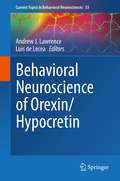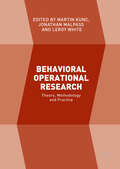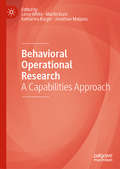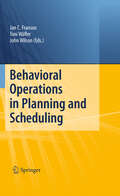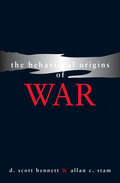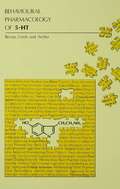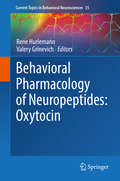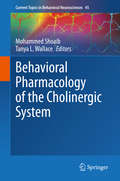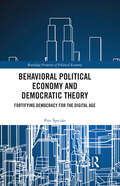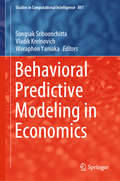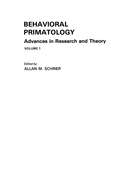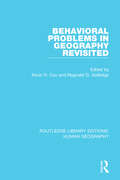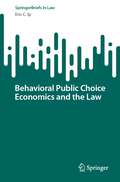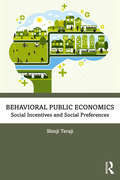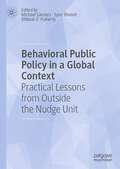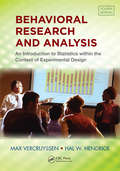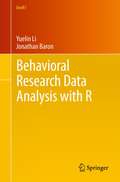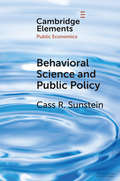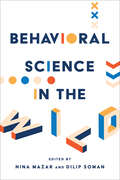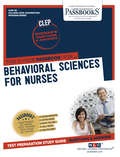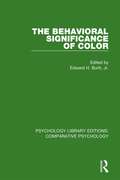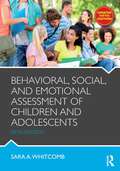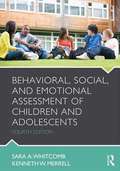- Table View
- List View
Behavioral Neuroscience of Orexin/Hypocretin (Current Topics in Behavioral Neurosciences #33)
by Andrew J. Lawrence Luis De LeceaThis issue of Current Topics in Behavioral Neuroscience focuses on the neuropeptide orexin (hypocretin) and brings together scientists from around the world who will provide a timely discussion of how this peptide regulates behavior. This is a fast-moving field, and with the incorporation of novel technologies, new breakthroughs are likely to continue. For example, the use of optogenetic approaches has enabled the identification of the role of orexin-containing neurons in arousal states, critical for higher order functioning. From a clinical perspective, genetic polymorphisms in hypocretin/orexin and orexin receptors are implicated in a number of psychiatric disorders. In addition, advanced clinical trials are currently underway for orexin receptor antagonists in the treatment of insomnia and sleep disorders. We aim to capture a broad audience of basic scientists and clinicians.
The Behavioral Neuroscience of Tinnitus (Current Topics in Behavioral Neurosciences #51)
by Grant D. Searchfield Jinsheng ZhangThe origins of tinnitus and the development of effective treatments to treat tinnitus have puzzled scientists and clinicians for centuries. Now ground breaking research is beginning to unlock its secrets. The Behavioral Neuroscience of Tinnitus provides critical and comprehensive discussions of the most recent developments in behavioral neuroscience research of tinnitus. Each chapter represents the most important contemporary account of the subject, with an emphasis on preclinical and clinical trials for the development of new diagnostics and therapeutics. New and emerging innovative approaches are covered whenever possible. Six topics are discussed in detail in this volume, which provide new insights in the etiology and mechanisms of tinnitus, new biomarkers towards objective and reliable diagnosis of tinnitus, pharmacological approaches towards curing tinnitus, bioengineering advances towards developing effective medical devices, as well as the latest in psychotherapy methods. The reviews in the volume expose researchers and clinicians, both new and experienced, to exciting advancements and state-of-the-art developments from preeminent researchers in the field of tinnitus.
Behavioral Operational Research: Theory, Methodology And Practice
by Martin Kunc Jonathan Malpass Leroy WhiteBehavioral research is making a significantimpact on many academic disciplines. Its status as the source of some of themost profound research in the social sciences is unparalleled. Therefore, it is not surprisingthatinterest in Behavior and Operational Research (OR) isburgeoning, even though understanding the relationship between knowledge, behaviorand action has been an academic preoccupation in OR since the beginning of thediscipline. This book introduces the idea of Behavioral OR,where the theoretical and empirical developments in the behavioral field aremaking an impression on OR academics and practitioners alike. The book providesa much needed overview that connects together theory, methodology and practiceand offers the "state of the art" on Behavioral Operational Research theory andpractice. The book not only includes chapters by leading academics, but alsoincludes rich and insightful real-life case studies by practitioners.
Behavioral Operational Research: A Capabilities Approach
by Leroy White Martin Kunc Katharina Burger Jonathan MalpassThis edited collection addresses the question of which capabilities and competencies enable Behavioral Operational Research to provide sustained improvement to decision processes. The aim is to show how a focus on capability and competency will not only meet short-term requirements for problem solving and decision support, but also build a solid foundation for the future. The contributors present recent advances in Behavioral OR, with a focus on the ways in which users of models deal with incomplete and imprecise information, subjective boundaries and uncertainty. These chapters are structured around three key dimensions of BOR: capabilities, cognition and aspects of practice.
Behavioral Operations in Planning and Scheduling
by Jan C. Fransoo John R. Wilson Toni WaeflerHuman and organizational factors have a substantial impact on the performance of planning and scheduling processes. Despite widespread and advanced decision support systems, human decision makers are still crucial to improve the operational performance in manufacturing industries. In this text, the state of the art in this area is discussed by experts from a wide variety of engineering and social science disciplines. Moreover, recent results from collaborative studies and a number of field cases are presented. The text is targeted at researchers and graduate students, but is also particularly useful for managers, consultants, and system developers to better understand how human performance can be advanced.
The Behavioral Origins of War
by D. Scott Bennett Allan C. StamInThe Behavioral Origins of War,D. Scott Bennett and Allan C. Stam analyze systemic, binary, and individual factors in order to evaluate a wide variety of theories about the origins of war. Challenging the view that theories of war are nothing more than competing explanations for observed behavior, this expansive study incorporates variables from multiple theories and thus accounts for war's multiplicity of causes. While individual theories offer partial explanations for international conflict, only a valid set of theories can provide a complete explanation. Bennett and Stam's unconventional yet methodical approach opens the way for cumulative scientific progress in international relations. D. Scott Bennett is Professor of Political Science at the Pennsylvania State University. Allan C. Stam is Associate Professor in the Government Department at Dartmouth College.
Behavioral Pharmacology of 5-ht
by Paul BevanThis volume reviews the current state of research within the behavioral pharmacology of 5-HT. The book opens exciting new approaches to the interdisciplinary study of behavior and pharmacology with special reference to ethology, endocrinology, neuroanatomy and comparative aspects of drug action, and notes new developments in therapeutic drugs of the future.
Behavioral Pharmacology of Neuropeptides: Oxytocin (Current Topics in Behavioral Neurosciences #35)
by Rene Hurlemann Valery GrinevichThis volume collects cutting-edge expert reviews in the oxytocin field and will be of interest to a broad scientific audience ranging from social neuroscience to clinical psychiatry. The role of the neuropeptide oxytocin in social behaviors is one of the earliest and most significant discoveries in social neuroscience. Influential studies in animal models have delineated many of the neural circuits and genetic components that underlie these behaviors. These discoveries have inspired researchers to investigate the effects of oxytocin on brain and behavior in humans and its potential relevance as a treatment for psychiatric disorders including borderline personality disorder and autism and schizophrenia spectrum disorders. In fact, there is no established social psychopharmacology in Psychiatry, and oxytocin can be seen as the first endogenous agent specifically addressing social-cognitive impairment in psychiatric disorders, with animal research suggesting that it could be especially efficient in the early postnatal period. From a human perspective, it is crucial to understand more precisely who can benefit from potential oxytocin-related treatments, which outcome measures will best represent their effects, how they should be administered, and what brain mechanisms are likely involved in mediating their effects. This type of “precision medicine” approach is in line with the research domain criteria defined by the U.S. National Institute of Mental Health.
Behavioral Pharmacology of the Cholinergic System (Current Topics in Behavioral Neurosciences #45)
by Mohammed Shoaib Tanya L. WallaceThe molecular genetics of the cholinergic system including both muscarinic and nicotinic acetylcholine receptors, cholinesterases, acetylcholine synthesis and release have provided significant insights into potential targeting for pharmacological intervention. Cholinergic drugs are being used or evaluated for the treatment of diseases. Thus, this volume aims to broaden our understanding of the current state of cholinergic mechanisms to enable implementation of novel approaches for the development of more effective treatments.
Behavioral Political Economy and Democratic Theory: Fortifying Democracy for the Digital Age (Routledge Frontiers of Political Economy)
by Petr ŠpeciánDrawing on current debates at the frontiers of economics, psychology, and political philosophy, this book explores the challenges that arise for liberal democracies from a confrontation between modern technologies and the bounds of human rationality. With the ongoing transition of democracy’s underlying information economy into the digital space, threats of disinformation and runaway political polarization have been gaining prominence. Employing the economic approach informed by behavioral sciences’ findings, the book’s chief concern is how these challenges can be addressed while preserving a commitment to democratic values and maximizing the epistemic benefits of democratic decision-making. The book has two key strands: it provides a systematic argument for building a behaviorally informed theory of democracy; and explores how scientific knowledge on quirks and bounds of human rationality can inform the design of resilient democratic institutions. Drawing these together, the book explores the centrality of the rationality assumption in the methodological debates surrounding behavioral sciences as exemplified by the dispute between neoclassical and behavioral economics; the role of (ir)rationality in democratic social choice; behaviorally informed paternalism as a response to the challenge of irrationality; and non-paternalistic avenues to increase the resilience of the democratic institutions towards political irrationality This book is invaluable reading for anyone interested in behavioral economics and sciences, political philosophy and the future of democracy.
Behavioral Predictive Modeling in Economics (Studies in Computational Intelligence #897)
by Songsak Sriboonchitta Vladik Kreinovich Woraphon YamakaThis book presents both methodological papers on and examples of applying behavioral predictive models to specific economic problems, with a focus on how to take into account people's behavior when making economic predictions. This is an important issue, since traditional economic models assumed that people make wise economic decisions based on a detailed rational analysis of all the relevant aspects. However, in reality – as Nobel Prize-winning research has shown – people have a limited ability to process information and, as a result, their decisions are not always optimal. Discussing the need for prediction-oriented statistical techniques, since many statistical methods currently used in economics focus more on model fitting and do not always lead to good predictions, the book is a valuable resource for researchers and students interested in the latest results and challenges and for practitioners wanting to learn how to use state-of-the-art techniques.
Behavioral Primatology: Advances in Research and Theory, Volume 1
by Allan M. SchrierFirst published in 1977. Routledge is an imprint of Taylor & Francis, an informa company.
Behavioral Problems in Geography Revisited (Routledge Library Editions: Human Geography #6)
by Kevin R Cox Reginald GolledgeThis collection of papers, originally published in 1981, reviews and evaluates past and possible future advances in a field of central importance to human geography: behavioral geography. The book includes critical studies which show how the approach has contributed substantially to work within four areas of amjor application in behavioral geography: urban travel behavior, environmental cognition, residential mobility and spatial diffusion. The final section of the book focuses on the shortcomings of the behavioral approach and considers the alternative modes of analysis available.
Behavioral Public Choice Economics and the Law (SpringerBriefs in Law)
by Eric C. IpThis book provides an accessible introduction to the emerging field of behavioral public choice economics and the law. This field studies how public officials, lawmakers, and judges fall prey to their own biases and heuristics, and how constitutions and judicial doctrines can be structured to mitigate these cognitive shortcomings. Written lucidly in plain language, this book is invaluable to all students, scholars, and general readers interested in behavioral economics, law and economics, and political economy.
Behavioral Public Economics: Social Incentives and Social Preferences
by Shinji TerajiBehavioral Public Economics shows how standard public economics can be improved using insights from behavioral economics. Public economics typically lists four market failures that may justify government intervention in markets—imperfect competition (or natural monopoly), externalities, public goods, and asymmetric information. Under the rational choice paradigm (‘agents choose what is best for them’), public economics has examined the welfare effects of policy. Recent research in behavioral economics highlights a fifth market failure—individuals may make mistakes in pursuing their own well-being. This book calls for a rethinking of assumptions of individual behavior and provides a good foundation for public economic theory. Key features: Introduces behavioral perspectives into public economics. Explains why economic incentives often undermine social preferences. Reveals that social incentives matter for public policy. This book will be an invaluable resource for researchers and postgraduate students in public economics, behavioral economics, and public policy.
Behavioral Public Policy in a Global Context: Practical Lessons from Outside the Nudge Unit
by Michael Sanders Syon Bhanot Shibeal O' FlahertyThe academic field of behavioral science has developed rapidly in recent decades. The field draws on research from across the social and natural sciences, and it has consistently shown that humans are not always rational. This insight has had a profound impact on multiple fields, including economics, political science, and law. Since the early 2000s, the application of behavioral science to public policy has also grown exponentially. Policymakers and practitioners now regularly use behavioral science to rethink how they develop programs and solve social problems. The impact has been far-reaching; behavioral science has transformed how we think about the economy, public health, education, and beyond. In practice, behavioral insights have been used to raise tax revenues, help people access social welfare program benefits and employment opportunities, increase voter turnout, boost medication adherence, and more. There are now hundreds of entities – international organizations, governments, business, and nonprofits – building and investing in internal behavioral science teams. Unfortunately, most of the hard work of putting these teams together and applying behavioral science insights happens “behind the scenes.” This book unearths some of the stories and insights from pioneers in applied behavioral science, in their own words. How did their teams come about, and how did they grow? What projects have worked, and which have not? What have they learned, and what would they recommend to others seeking to build behavioral science teams of their own?
Behavioral Rationality and Heterogeneous Expectations in Complex Economic Systems
by Cars HommesRecognising that the economy is a complex system with boundedly rational interacting agents, the book presents a theory of behavioral rationality and heterogeneous expectations in complex economic systems and confronts the nonlinear dynamic models with empirical stylized facts and laboratory experiments. The complexity modeling paradigm has been strongly advocated since the late 1980s by some economists and by multidisciplinary scientists from various fields, such as physics, computer science and biology. More recently the complexity view has also drawn the attention of policy makers, who are faced with complex phenomena, irregular fluctuations and sudden, unpredictable market transitions. The complexity tools - bifurcations, chaos, multiple equilibria - discussed in this book will help students, researchers and policy makers to build more realistic behavioral models with heterogeneous expectations to describe financial market movements and macro-economic fluctuations, in order to better manage crises in a complex global economy.
Behavioral Research and Analysis: An Introduction to Statistics within the Context of Experimental Design, Fourth Edition
by Max Vercruyssen Hal W. HendrickNow in its fourth edition, Behavioral Research and Analysis: An Introduction to Statistics within the Context of Experimental Design presents an overview of statistical methods within the context of experimental design. It covers fundamental topics such as data collection, data analysis, interpretation of results, and communication of findings
Behavioral Research Data Analysis with R (Use R!)
by Jonathan Baron Yuelin LiThis book is written for behavioral scientists who want to consider adding R to their existing set of statistical tools, or want to switch to R as their main computation tool. The authors aim primarily to help practitioners of behavioral research make the transition to R. The focus is to provide practical advice on some of the widely-used statistical methods in behavioral research, using a set of notes and annotated examples. The book will also help beginners learn more about statistics and behavioral research. These are statistical techniques used by psychologists who do research on human subjects, but of course they are also relevant to researchers in others fields that do similar kinds of research. The authors emphasize practical data analytic skills so that they can be quickly incorporated into readers' own research.
Behavioral Science and Public Policy (Elements in Public Economics)
by Cass R. SunsteinBehavioral science is playing an increasing role in public policy, and it is raising new questions about fundamental issues - the role of government, freedom of choice, paternalism, and human welfare. In diverse nations, public officials are using behavioral findings to combat serious problems - poverty, air pollution, highway safety, COVID-19, discrimination, employment, climate change, and occupational health. Exploring theory and practice, this Element attempts to provide one-stop shopping for those who are new to the area and for those who are familiar with it. With reference to nudges, taxes, mandates, and bans, it offers concrete examples of behaviorally informed policies. It also engages the fundamental questions, include the proper analysis of human welfare in light of behavioral findings. It offers a plea for respecting freedom of choice - so long as people's choices are adequately informed and free from behavioral biases.
Behavioral Science in the Wild (Behaviorally Informed Organizations)
by Nina Mažar Dilip SomanBehavioral Science in the Wild helps managers understand how best to incorporate key research findings to solve their own behavior change challenges in the real world – from lab to field. Behavioral Science in the Wild helps managers to implement research findings on behavioral change in their own workplace operations and to apply them to business or policy problems. As the second book in the Behaviourally Informed Organizations series, Behavioral Science in the Wild takes a step back to address the "why" and "how" behind the origins of behavioral insights, and how best to translate and scale behavioral science from lab-based research findings. Governments, for-profit enterprises, and welfare organizations have increasingly started relying on findings from the behavioral sciences to develop more accessible and user-friendly products, processes, and experiences for their end-users. While there is a burgeoning science that helps us to understand why people act and make the decisions that they do, and how their actions can be influenced, we still lack a precise science and strategic insights into how some key theoretical findings can be successfully translated, scaled, and applied in the field. Nina Mažar and Dilip Soman are joined by leading figures from both the academic and applied behavioral sciences to develop a nuanced framework for how managers can best translate results from pilot studies into their own organizations and behavior change challenges using behavioral science.
BEHAVIORAL SCIENCES FOR NURSES: Passbooks Study Guide (College Level Examination Program Series (CLEP))
by National Learning CorporationThe College Level Examination Program (CLEP) enables students to demonstrate college-level achievement and earn college credit in various subject areas based on knowledge acquired through self-study, high school and adult courses, or through professional means. The CLEP Behavioral Sciences for Nurses Passbook® prepares you by sharpening knowledge of the skills and concepts necessary to succeed on the upcoming exam and the college courses that follow. It provides a series of informational texts as well as hundreds of questions and answers in the areas that will likely be covered on your upcoming exam.
The Behavioral Significance of Color (Psychology Library Editions: Comparative Psychology)
by Edward H. Burtt JRPrior to publication the study of animal coloration was plagued by fanciful speculations, post hoc explanations and untestable hypotheses. This title, originally published in 1979, draws together widely scattered research into the coloration of animals; formulates predictive hypotheses to account for color; documents the accuracy of many of these hypotheses; and suggests directions for future research. The book grew out of a symposium, The Behavioral Significance of Color at the 1977 meeting of the Animal Behavior Society, and presents evidence concerning patterns of coloration and their influence on animal behaviour and interaction Physical principles of radiation are discussed in Chapter 1, followed, in subsequent chapters, by an examination of the physiological functions of animal coloration (e.g. thermoregulation, hydroregulation, abrasion-resistance, extraretinal photoreception). Treatment of coloration that affects the animal’s visibility to other animals opens with a masterful overview of theories of color vision and its occurrence throughout the animal kingdom. Chapter 6 explores the role of color vision and fruit color in the selection of food by wild primates with comments on the coevolution of fruiting trees and their primate customers. Dr Jack P. Hailman addresses the elusive concept of conspicuousness. He summarizes a strategy for calculating conspicuous coloration based on measurements in natural habitats. Experiments, naturalistic observations and anecdotes of optical communication are exceedingly numerous. Chapters 8 and 9 review these data and suggest general principles of inter- and intraspecific optical communication. Each chapter is enhanced by the critical evaluations of Drs. C. Richard Tracy and W. J. Hamilton III. In closing, the editor discusses coloration as it affects an animal’s own vision (e.g., black eyelines to reduce glare). Most significantly the book emphasizes the need for a balanced, scientifically rigorous approach to the question of evolution of animal coloration. It is an important source for anyone contemplating or currently involved in research in this field of investigation.
Behavioral, Social, and Emotional Assessment of Children and Adolescents
by Sara A. WhitcombGenerally recognized as the standard work in its field, Behavioral, Social, and Emotional Assessment of Children and Adolescents is a comprehensive guide for conducting conceptually sound, culturally responsive, and ecologically oriented assessments of students’ social and emotional behavior. Written for graduate students, practitioners, and researchers in the fields of school psychology, child clinical psychology, and special education, it will also be of interest to those in related disciplines. Building on the previous editions, this fifth edition includes updated references to DSM-5 and federal standards as well as an integrated approach to culturally competent assessment throughout the text. In Part I, Foundations and Methods of Assessment, the author provides a general foundation for assessment practice and outlines basic professional and ethical issues, cultural considerations, and classification and diagnostic problems. Part II, Assessment of Specific Problems, Competencies, and Populations, includes material on assessing specific social–emotional behavior domains, including externalizing problems, internalizing problems, social skills and social–emotional strengths, and the unique needs of young children. A chapter on school-wide screening methods was also added with this edition. By weaving together the most recent research evidence and common application issues in a scholarly yet practical matter, Behavioral, Social, and Emotional Assessment of Children and Adolescents continues to be the pre-eminent foundation for assessment courses.
Behavioral, Social, and Emotional Assessment of Children and Adolescents
by Sara Whitcomb Kenneth W. MerrellGenerally recognized as the standard work in its field, Behavioral, Social, and Emotional Assessment of Children and Adolescents provides a comprehensive foundation and guide for conducting conceptually sound, culturally responsive, and ecologically-oriented assessments of student social and emotional behavior. It is aimed at graduate students, practitioners, and researchers in the fields of school psychology, child clinical psychology, and special education, but will also be of interest to those in related disciplines such as counseling psychology, child psychiatry, and social work. Keeping intact many of the same premises and pedagogy of the previous editions, this revised and updated fourth edition has been re-organized to emphasize culturally responsive reflective practice, with added content including updated assessment tools and strategies to be used within a Response to Intervention (RtI) framework. In addition to updating all chapters to reflect current research and data, authors Sara Whitcomb and Kenneth Merrell move away from a more narrow view of social skills to reflect an expanded notion of strengths-based assessment, which includes such traits as coping skills, resilience, problem-solving ability, emotional knowledge, and empathy. Throughout, they strive to increase professional standards in the practice of psychological and educational assessment of children and adolescents, providing a solid, evidence-based foundation for assessment.
